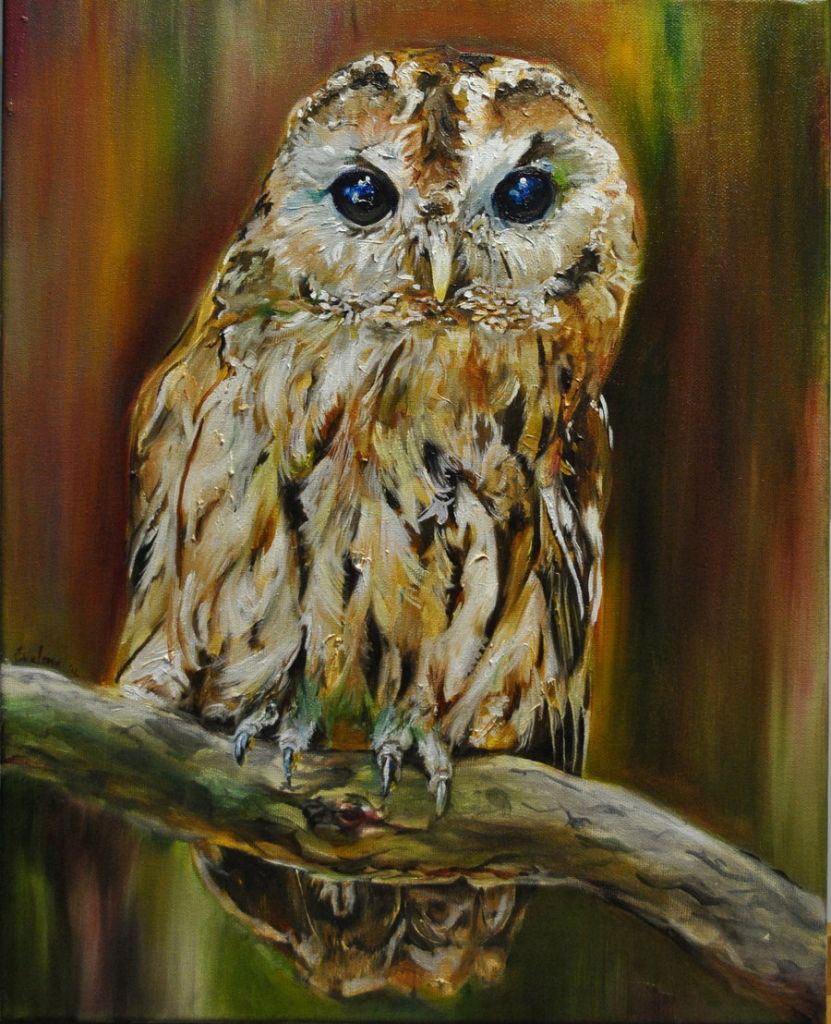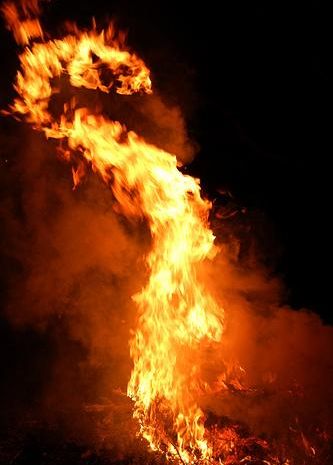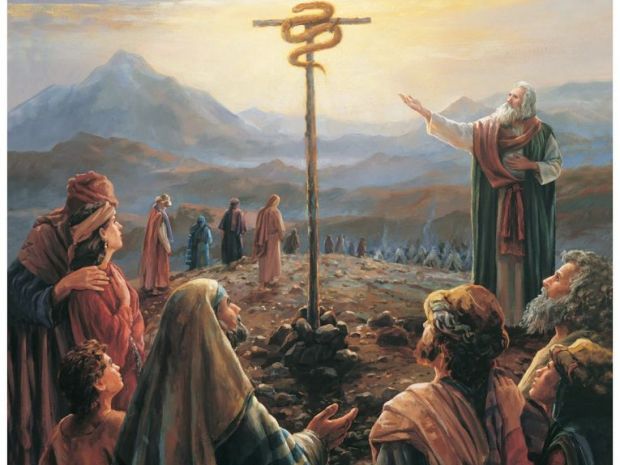
16 Oct 2014 by Yeo Teck Thiam-
When we think of serpents and dinosaurs, our interests may be mostly scientific curiosity and interests. So we have also sought to know whether the Bible has much to tell us of such creatures.
Nevertheless, the Bible is given to us as God’s word for our spiritual edification. It will be a sorrowful tale if we ignore what God has to tell us in our quest for knowledge. For we know Scripture tells us of things for understanding and wisdom, so we know these creatures have symbolical and spiritual significance. So we seek the Lord to open our eyes to see, and to teach us, as we move on.
Fishes, Birds and Winged Creatures
In the context of Creation, I think it is important to know also that Genesis does not merely describe birds and fishes only. This is seen in Genesis 1:20, 21, as well:
And God said, “Let the waters swarm with swarms of living creatures, and let birds fly above the earth across the expanse of the heavens.”
So God created the great sea creatures and every living creature that moves, with which the waters swarm, according to their kinds, and every winged bird according to its kind. (ESV)

Here, I have included the English Standard Version, so that we may look at the careful ways that have been taken in translation, to tell us what God said in an English language context.
Our modern classification of species and animal orders into mammals, birds, insects, reptiles and so forth, exists only in the last 200 years. So we are careful not to limit Creation to our ideas of modern classifications and names only.
The swarms of creatures created include “winged creature” and “sea creature”. We surmise that this means more than just creating birds and fishes.
The Hebrew word “owph” (or “owf”) corresponds to a bird, or flying, winged creature. However, in order to emphasize this clearly, Genesis 1:21 included every “winged bird”. The extra Hebrew word “kanaph” is used to indicate “winged”, so Genesis 1:21 says, every “kanaph owph”. Thus I take this double emphasis to mean every “winged flying creature”.

So we also find the contrasting description of “owph” as “winged” or “flying” in Leviticus 11:20, as it is written: “All flying insects on all fours are to be detestable to you.” (NIV) The Hebrew words used are “owph seres” where “seres” means insects.
Allusions to Unclean Birds
In speaking of birds, there is a curious but important list of unclean birds given in Leviticus 11:13-22. The birds were not to be eaten by the Israelites, as these were called unclean. The English naming of these birds is an awesome task. We can see this difficulty in the description of many types of owls!
One has to imagine the necessity to spell out the different owls, since most of us cannot tell the difference between a desert owl and a white owl. This covenant was given in Israel’s sojourn through the desert, so the naming of different birds in the Exodus provided an interestingly curious emphasis.
Our impression of the owl as a wise creature is rather Western in outlook. For many cultures, the owl does not have this symbolic wisdom. Rather, the owl is a bird that stalks in the night and the desert. It is a skilful, silent predatory creature that swoops on mice and small animals. Like the vulture and eagle, these birds are meat eaters and are very different from the dove.

Interestingly also, for one unclean animal described, the Hebrew word, “tinshemet” is used. This creature is variously described as a bird, a lizard, a gecko, a swan, a water hen, white owl, a barn owl, or a combination animal. It is curious because scholars have debated on its exact meaning. Perhaps someday, we will know when we meet the Lord.
I mention this because in Leviticus 11:18, it describes a bird in the group. But in Leviticus 11:30, it implies a reptile in that group. For this reason, “tinshemet” is a curious reference of a bird – reptile that the Lord knows, and must tell us!
Many will know the archaeopteryx was a strange feathered bird-reptile in times past. So we should not dismiss the tinshemet was wrongly listed in Leviticus.
In contemplating on these awesome and nondescript creatures, we may not be able to define their physical features. We must leave the quest here, as many things remain to be uncovered.
About Leviathan and Crocodiles
The Israelites lived in Egypt from the time of Joseph till Moses, and they would be familiar with the crocodiles of the Nile River. Nonetheless, crocodiles are not directly named in the Old Testament.
Instead, we read of the Leviathan in some five passages. The text in Job 41:1-34 describes Leviathan like the crocodile that we know in present day; nevertheless, this is by no means exact. In this passage, God asked Job to gird up his loins and face the questions that God has for him.
Naturally, Job had no answer to acquit himself, and the ways of the Leviathan was one subject that Job could not explain with his human wisdom. Hence, I do not presume to equate Leviathan as equivalent of the crocodile where Job has no answers for God!
In Isaiah 27:1, we have another picture. This time, the picture is symbolically that of a bending and twisting serpent, as it is written:
“In that day the LORD with hard and great and strong sword will punish Leviathan the fleeing serpent, Leviathan the twisting serpent, and he will slay the dragon that is in the sea.” (ESV)

This passage in Isaiah speaks of the punishment that is decreed on Assyria. We can see that Leviathan is spoken of symbolically.
With this, I must leave these unidentified but awesome creatures for the Lord to reveal in His time. The Leviathan mentioned in Psalm 74:14 and 106:26 are hard to define.
Allusions to Dragons
In contemplating on these creatures, there is an important spiritual aspect that Scripture reminds us. So I think it is worthwhile to consider the spiritual significance of the dragon in Scripture. We see this mentioned in Isaiah 27:1 when the LORD decreed punishment for Assyria.
“Tannyin” is used to mean the dragon in the Old Testament. Even though we do not have an exact idea of how it looks like, yet we know almost every culture and language speaks of a dragon.
Our common image of the dragon is a fearsome serpent-like creature, perhaps able to fly, have four legs, and spits out water or fire. It resembles the snake in some aspects, and this is usually in the facial context. However, somewhere in our distant past, we also seem to recall it had legs, unlike the present day snake.
Perhaps, this provides reason that the “tannyin” also describes a specific animal, and is identified with the dragon in Scripture. It has references to Satan, as reflected in several passages of the New Testament.

Likewise, this is also confirmed in Job 26:11-13 and Isaiah 51:9-11. Both passages allude to Rahab in the context of rebellion against God. Rahab means proud and arrogant in Hebrew.
So we read in Job 26:11-13:
The pillars of heaven tremble and are astounded at his rebuke.
By his power he stilled the sea; by his understanding he shattered Rahab.
By his wind the heavens were made fair; his hand pierced the fleeing serpent.” (ESV)
And we read from Isaiah 51:9,
“Awake, awake, put on strength, O arm of the LORD;
Awake, as in the days of old, the generations of long ago.
Was it not you who cut Rahab in pieces,
who pierced the dragon? (ESV)
Rahab’s rebellion against God relates to the Creation, particularly against God in the making of light to come about in the heavens, and in restoration of order from chaos in the universe. The cohorts of Rahab opposed God in creating the heavens and the earth. So by His breath, God made the universe to have order. And God’s hand pierced the serpent as he fled.
In Job 26:13, the Hebrew word used for serpent is “nachash”. But in Isaiah 51:9, the word is “tannyin” for dragon. We see that these describe a serpent that is also the dragon as the enemy, just as Revelation 20:2 tells us about Satan. In these passages, the rebellion against God is clear.

Likewise, when God provides us with angelic support against Satan, it is written in Psalm 91:13:
You will tread upon the lion and the cobra;
you will trample the great lion and tannyin. (NIV)
Thus Scripture confirms this for us in the New Testament:
The God of peace will soon crush Satan under your feet. (Romans 16:20)
So it is also written about our God:
It was you who split open the sea by your power;
you broke the heads of tannyin in the waters. (Psalm 74:13, NIV)
The spiritual significance of rebellion associated with tannyin in its pride and arrogance runs through many of these passages. It has close association with Satan’s rebellion. Satan’s pride as a splendid created being led him to sin, and to rebel against God.
The Bronze Serpent in the Exodus
Before closing these considerations, I will like to mention, as a contrast, the fiery serpent that God command Moses to set up while the Israelites were sojourning through the wilderness.
The people were disgruntled that they must journey through the desert. The people were looking forward to a land of milk and honey that God promised. But here, in the desert, they had to endure hardship and bland food. They grumbled that this was not what they bargained for.
The LORD heard these complaints, and He punished their rebellious grumblings by sending fiery serpents that bit them. Many people died from these attacks. As a result, the Israelites came to Moses to confess their sinfulness and evil, and entreated Moses to ask God to heal them, and to take away the scourge of these serpents.
So God commanded Moses to set up the fiery creature for the people. The people would be healed from the serpents’ bites when they looked on the fiery creature that was lifted up. Numbers 21:4-9.

Here, the Hebrew word “nachash” is used for the serpent, while the fiery description is from the Hebrew word “saraph”. “Saraph” has the meaning of burnng, of being fiery, and its spiritual symbolism of burning conveys the cleansing of sins. Thus “saraph nachash” means fiery serpents.
Many will be familiar with the Hebrew word “saraph” as this is the same word used for the angelic beings called seraphim that Isaiah saw before the throne of God. The passage in Isaiah 6:2-6 described the seraphim, and one of them took a burning coal to touch Isaiah so that he would be cleansed.
Nonetheless, the amazing detail in this account is what God commanded Moses to set up! God called for a “saraph”!
However, Scripture tells us Moses set up the “bronze serpent” to represent “saraph”!
So it is written:
And the LORD said to Moses, “Make a saraph and set it on a pole, and everyone who is bitten, when he sees it, will live. So Moses made a bronze nachash and set it on a pole.” (Numbers 21:8, 9, ESV)

Here, we have an amazing switch from a fiery serpent “saraph nachash” that bit the Israelites in the desert, to that of a “saraph” in God’s command to Moses for healing.
On account of this, when Jesus said that He would be lifted up and heal people of their sins, He was not lifted up like a serpent, but like the healing saraph in the Exodus. Jesus would heal people, just like Isaiah saw in his vision when one of the seraphim brought him burning coals to cleanse him of his sins in a spiritual and symbolic manner.
Words fail to describe these amazing pictures. But praise the Lord for His saving grace!
Note: Mr Yeo Teck Thiam is a retireer who used to work as a chemical engineer, specializing in food and perfume chemistry for an international food company and perfumer. His other main interest is astronomy and other mathematical matters, relating to the Biblical passages.
| Share the Good News |




Leave a Reply